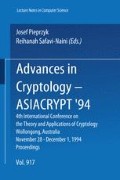Abstract
Since 1975 many new cryptosystems have been based on elementary number theory, but until now it has not been recognised that they have been just as much grounded in the process of exponentiation. Lucas functions can be used to replace exponentiation to produce alternative cryptosystems that are not susceptible to attacks which rely on the fact that multiplication is closed under exponentiation, since Lucas functions do not exhibit this closure.
Preview
Unable to display preview. Download preview PDF.
References
E. Bach, “Intractable Problems in Number Theory”, Advances in Cryptology: Proceedings of CRYPTO '88, Springer-Verlag, Berlin, 1989, pp 105–122.
J. Buchmann & Loho & Zayer, “An Implementation of the general number field sieve”, Advances in Cryptology: Proceedings of CRYPTO '93, Springer-Verlag, Berlin, 1994, pp 159–165.
T. Denny and B. Dodson and A.K. Lenstra A. K. Manasse and M.S. Manasse, “On the factorization of RSA-120”, Advances in Cryptology: Proceedings of CRYPTO '93, Springer-Verlag, Berlin, 1994, pp 166–174.
T. El Gamal, “A public-key cryptosystem and a signature scheme based on discrete logarithms”, IEEE Transactions on Information Theory 31 (1985), pp 469–472.
T. El. Gamal and B. Kaliski, Dr. Dobb's Journal, letter to the editor, 18, No.5, May 1993, p10.
D.M. Gordon, “Discrete Logarithms in GF(p) using the Number Field Sieve”, Siam J Disc Math 6 No. 1, Feb 1993, pp 124–138.
D. H. Lehmer, “An extended theory of Lucas' functions”, Annals of Math., 31 (1930) pp 419–448.
F. E. A. Lucas, “Théorie des fonctions numériques simplement périodiques”, American Jnl Math, 1 (1878) pp 184–240, 289–321.
A. J. Menezes, T. Okamoto, S. A. Vanstone, “Reducing Elliptic Curve Logarithms to Logarithms in a Finite Field”, IEEE Transactions on Information Theory 39 (1993), pp 1639–1646.
C. Pomerance, “Fast Factorization & Discrete Logarithm Algorithms”, Discrete Algorithms & Complexity, W. Rheinboldt et al, Proceedings 1986 Kyoto Conference on Algorithms and Complexity.
P. Smith and M. Lennon, “LUC: A new public-key system”, Proceedings of IFIP/Sec '93, Elsevier Science Publications, 1994.
Author information
Authors and Affiliations
Editor information
Rights and permissions
Copyright information
© 1995 Springer-Verlag Berlin Heidelberg
About this paper
Cite this paper
Smith, P., Skinner, C. (1995). A public-key cryptosystem and a digital signature system based on the Lucas function analogue to discrete logarithms. In: Pieprzyk, J., Safavi-Naini, R. (eds) Advances in Cryptology — ASIACRYPT'94. ASIACRYPT 1994. Lecture Notes in Computer Science, vol 917. Springer, Berlin, Heidelberg. https://doi.org/10.1007/BFb0000447
Download citation
DOI: https://doi.org/10.1007/BFb0000447
Published:
Publisher Name: Springer, Berlin, Heidelberg
Print ISBN: 978-3-540-59339-3
Online ISBN: 978-3-540-49236-8
eBook Packages: Springer Book Archive

